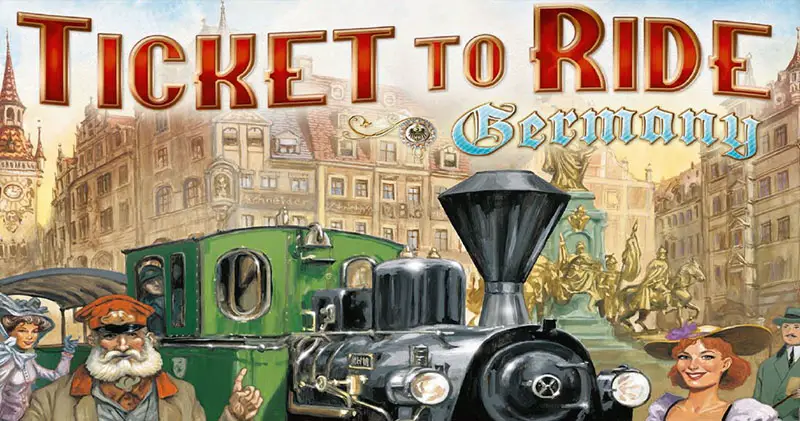
Components
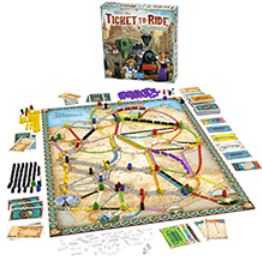
- 1 board map of Germany
- 225 Colored Train Cars
- 110 Train Car Cards
- 89 Destination Ticket Cards
- 1 Bonus Card
- 60 Passenger Meeples
- 1 Cloth Bag
- 5 Scoring Markers
- 1 Rules Booklet
Setup
Place the board map in the center of the table. Place the 60 Passenger Meeples in the bag and shuffle them. Then, draw the Passengers from the bag randomly and place them on the board according to the diagram.
Each player takes a set of 45 Colored Train Cars along with its matching Scoring Marker.
Each player places his Scoring Marker close to the Scoring Track running along the map's border 1. Throughout the game, each time a player scores points, he will advance his marker accordingly.
Shuffle the Train Car cards and deal a starting hand of 4 cards to each player 2. Place the remaining deck of Train Car cards near the board and turn the top five cards from the deck face up 3.
Place the Globetrotter Bonus Card face up next to the board 4.
Separate the Destination Tickets into one deck of Short Tickets (Blue backs) and a second deck of Long Tickets (Brown backs). Shuffl e both decks. At the beginning of the game, each player draws four Tickets.
A player may draw any combination of the two types of Tickets, but he must first announce what combination of Tickets he is drawing.
Each player then looks at his Destination Tickets and decides which ones he wishes to keep. He must keep at least two, but may keep three or all four if he chooses 5.
Unwanted Tickets are placed back into their respective decks. The two decks are reshuffled, and then placed separately next to the board 6. Players keep their Destination Tickets secret until the end of the game. You are now ready to begin.
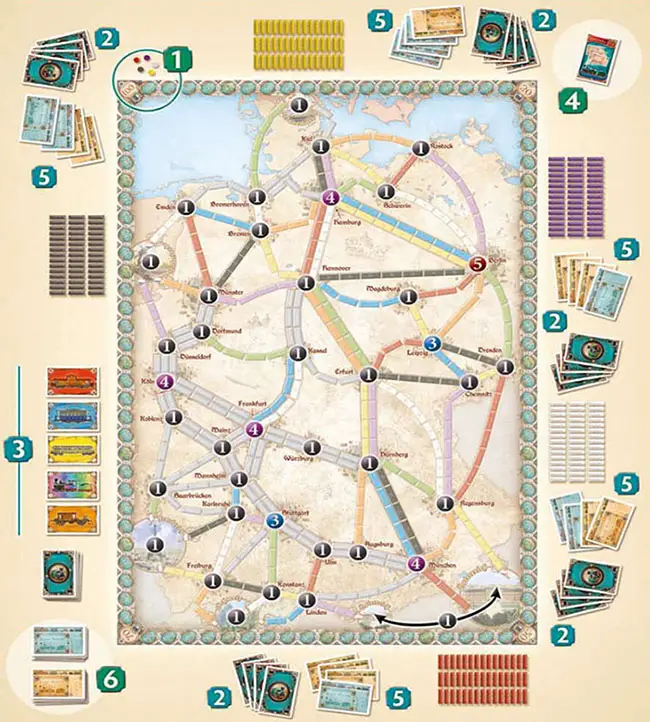
Object of the Game
The object of the game is to score the highest number of total points. Points can be scored by:
Claiming a Route on the map;
Successfully completing a Continuous Path of routes be- tween two cities (or a city and one of Germany's neigh- boring countries) listed on your Destination Ticket(s);
Completing the most Destination Tickets.
Collecting a majority of Passenger Meeples in each color.
Points are deducted from the players' total scores for each of their Destination Tickets that are not successfully completed by the end of the game.
Game Play
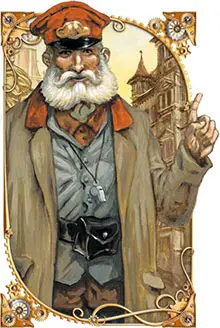
The oldest player goes first. Play then proceeds clockwise around the table, each player taking one turn at a time until the game ends. On his turn, a player must perform one (and only one) of the following three actions:
Draw Train Car Cards
The player may draw two Train Car cards. He may take any one of the face up cards or he may draw the top card from the deck (this is a blind draw).
If he draws a face up card, he immediately turns a replacement card face up from the deck. He then draws his second card, either from the face up cards or from the top of the deck. (See Locomotives for special rules).
Claim a Route & Collect Passenger Meeples
The player may claim a route on the board by playing a set of Train Car cards that match the color and length of the route and then placing one of his colored trains on each space of this route.
He immediately records his score by moving his Scoring Marker the appropriate number of spaces (see "Route Scoring Table") along the Scoring Track on the board. He then collects a Passenger Meeple from both spots surrounding the route he just claimed.
Draw Destination Tickets
The player draws four Destination Tickets from the top of the decks. He must keep at least one of them, but he may keep two, three or all four if he chooses. Any returned cards are placed on the bottom of their corresponding deck.
Drawing Train Car Cards
There are 8 types of regular Train Car cards, plus Locomotive cards. The colors of each type of Train Car card match various routes between cities on the board - Purple, Blue, Orange, White, Green, Yellow, Black, and Red.
A player may have any number of cards in his hand at any time. When the deck is exhausted, the discards are reshuffled into a new draw pile deck. The cards should be shuffled thoroughly, since all the cards have been discarded in sets.
In the unlikely event that there are no cards left in the deck and there are no discards (because players are hoarding cards), a player cannot draw Train Car cards on their turn. Instead he may only claim a route or draw Destination Ticket cards.
Locomotives
Locomotives are multi-colored and act as wild cards that can be part of any set of cards when claiming a route. If a face- up Locomotive card is picked during a card draw, it must be the only card picked that turn.
If a Locomotive is turned over as a replacement for a first card draw during the turn, or if a Locomotive is available face-up but not picked as the first (and only) card, it cannot be selected as a second card.
If, at any time, three of the five face up cards are Locomotives, all five cards are immediately discarded and five new ones are turned face up to replace them.
Note: If a player is lucky enough to get a Locomotive from the top of the deck in a blind draw, it counts as a single card and he may still draw a second card that turn.
Claiming Routes & Collecting Passenger Meeples
Claiming Routes
A route is a set of continuous colored spaces (in some in- stances, gray spaces) between two adjacent cities on the map or between a city and one of Germany's neighboring countries.
To claim a route, a player must play a set of cards equal to the number of spaces in the route. The set of cards must all be matching (along with any Locomotive cards) and most routes require a specific color.
For example a Blue route must be claimed using blue-colored Train Car cards. Some routes - those that are Gray colored - can be claimed using a set of cards of any one color.
When a route is claimed, the player places one of his plastic trains in each of the spaces of the route. All the cards in the set used to claim the route are then discarded. A player may claim any open route on the board.
He is never required to connect to any of his previously played routes. A player may only claim a maximum of one route on his turn.
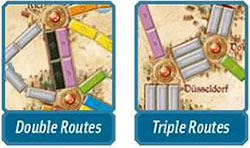
Some cities are connected by Double or Triple Routes. The same player cannot claim more than one of these routes during the game.
Important Note: In 2 and 3 player games, only one Route of the Double or Triple Routes joining two cities can be claimed. Once a player has claimed one of these, the other Route(s) forming the Double or Triple Route are locked and unavailable to other players.
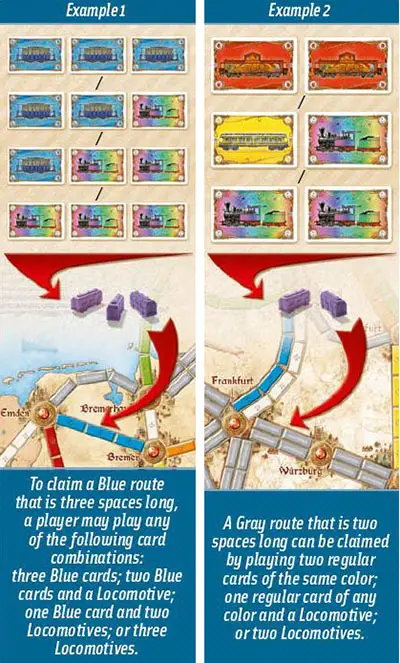
Collecting Passenger Meeples
Once a player has claimed a route, he may take one Passenger Meeple from each of the two cities (or country space) that were just connected. If there are multiple Passengers in a city, he can choose which one to take.
If there are no Passengers in a city, he does not get one from that city. Players add their collected Passengers to a growing pool of figures that are visible to everyone at the table.
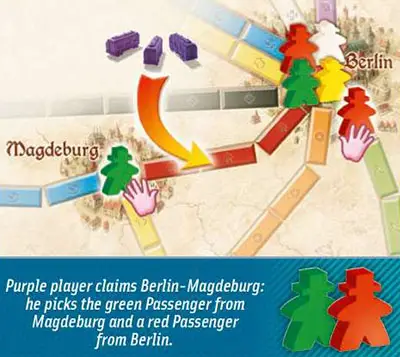
Route Scoring Table
When a player claims a route, he immediately scores the number of points indicated on the Route Scoring Table for the length of the route he just claimed.
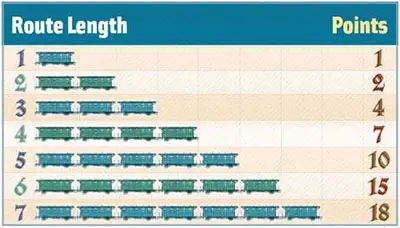
Drawing Destination Ticket Cards
A player can use his turn to draw more Destination Ticket Cards.
To do so, he draws four new cards from the top of either of the two Destination Ticket Decks. A player may draw any combination of the two types of Tickets, but he must first announce what combination of Tickets he is drawing.
If there are less than four Destination Tickets left in the decks, the player only draws the available cards. He must keep at least one of the cards, but may also keep two, three or all four if he chooses. Any returned cards are placed at the bottom of their corresponding deck.
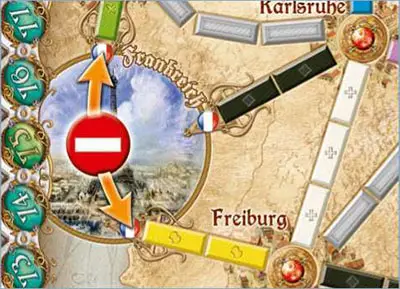 Even if Freiburg and Saarbrucken are both connected to France (Frankreich), they are not considered connected together. |
Each Destination Ticket includes the name of two cities on the map and a Point Value. If a player successfully completes a series of routes that connect the two cities, he will add the amount of points indicated on the Destination Ticket to his point total at the end of the game.
If he does not successfully connect the two cities, he deducts the amount of points indicated. Some Destination Tickets include the name of one of Germany's neighboring countries instead of one (or both) of the cities.
Each route leading to one of those countries is a dead end and separate from others: Different routes leading toward the same country are not considered connected together.
Destination Tickets are kept secret from other players until final scoring. A player may accumulate any number of Destination Ticket cards during the game.
End of the Game
When any player's stock of colored plastic trains gets down to only 0,1 or 2 trains left at the end of his turn, each player, including that player, gets one final turn. The game then ends and players calculate their final scores.
Calculating Scores
Players should have already accounted for the points earned as they completed different routes. To make sure no mistakes were made, you may want to re-count the points for each player's routes.
Players should then reveal all their Destination Tickets and add (or subtract) the value of their Destination Tickets, based on whether or not they succeeded in connecting those cities (and/or countries) together.
The player who has completed the most Destination Tickets receives the Globetrotter Bonus Card and adds 15 points to his score. In the case of a tie for the most completed tickets, all tied players score the 15 bonus points. Tickets that were not completed have no effect for the purpose of determining which player earns this bonus.
Finally, each player scores additional points for the Passengers they collected during the game. A player will score 20 points per color he leads in and 10 points per color he has the second most Passengers in.
If two or more players are tied for the most Passengers in a color, they each score 20 points and no player scores points for the second most Passengers. If one player has the most Passengers in a color and two or more players are tied for the second most, all of the tied players score 10 points.
The player with the most points wins the game.
If two or more players are tied for the most points, the player (among those tied) who has completed the most Destination Tickets wins.
In the unlikely event that they are still tied, the player with the most Passenger Meeples wins. If players are somehow still tied after checking both of these conditions, they share the victory.
Other Ticket to Ride Games
Continue Reading


